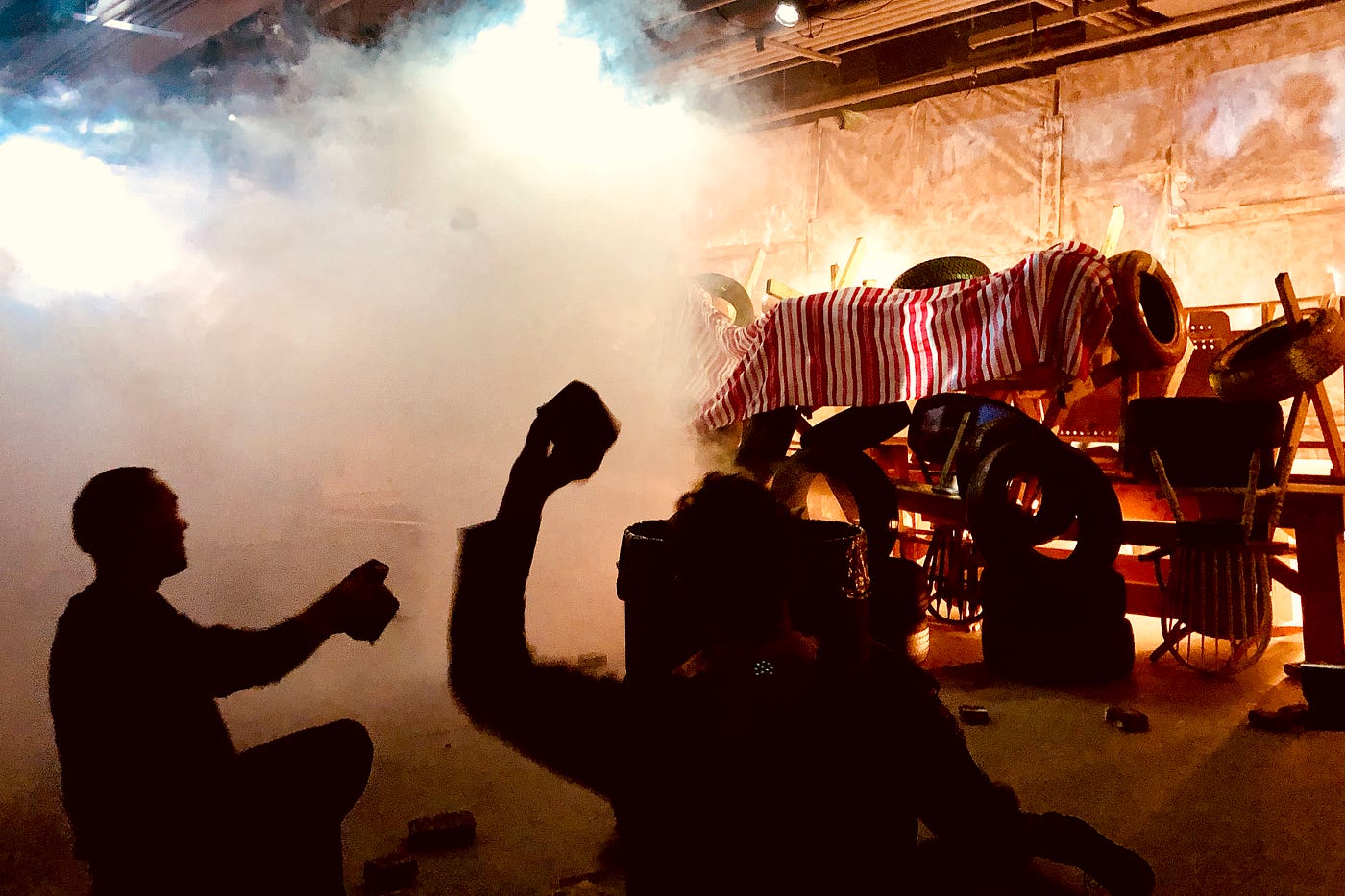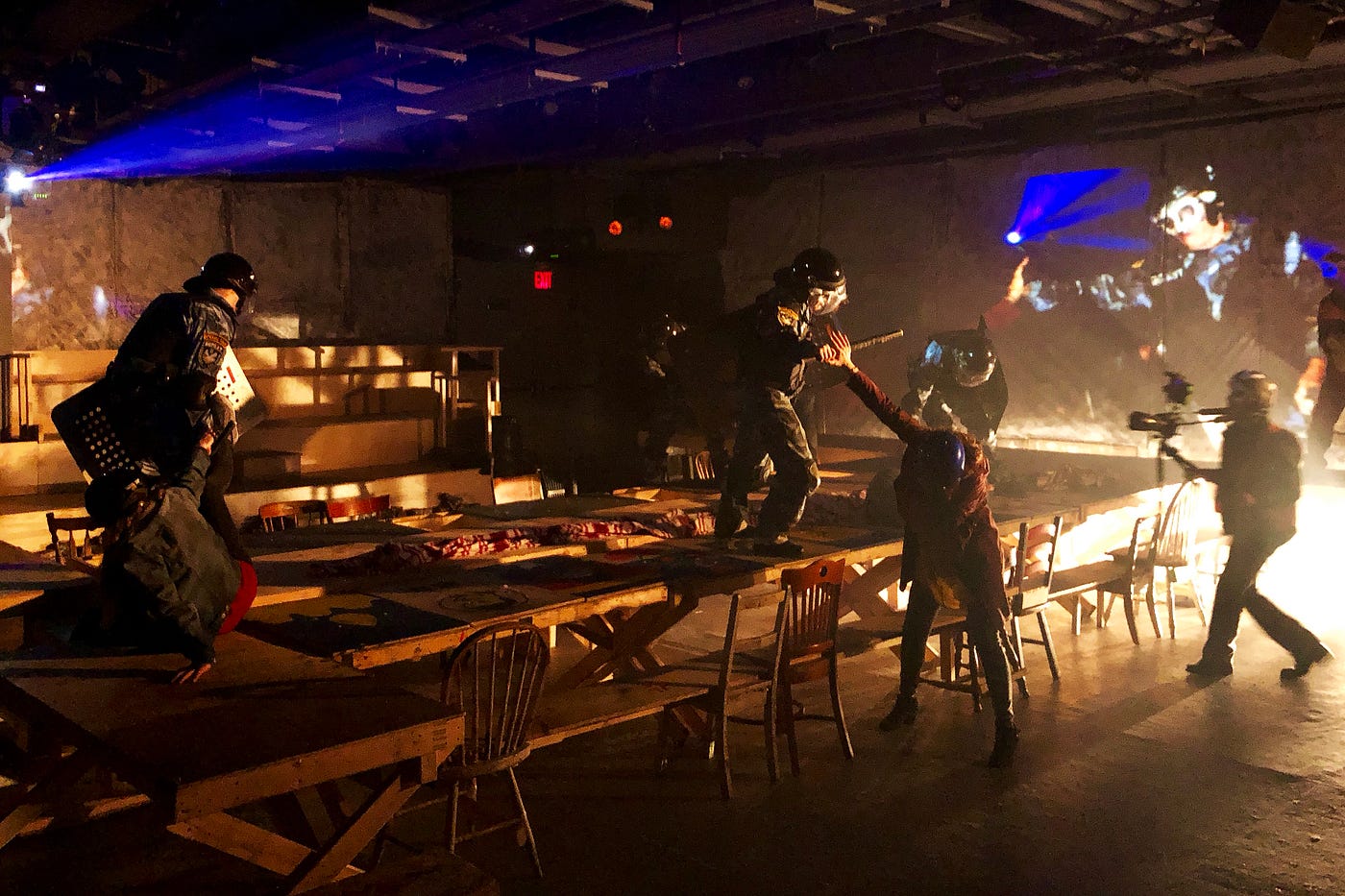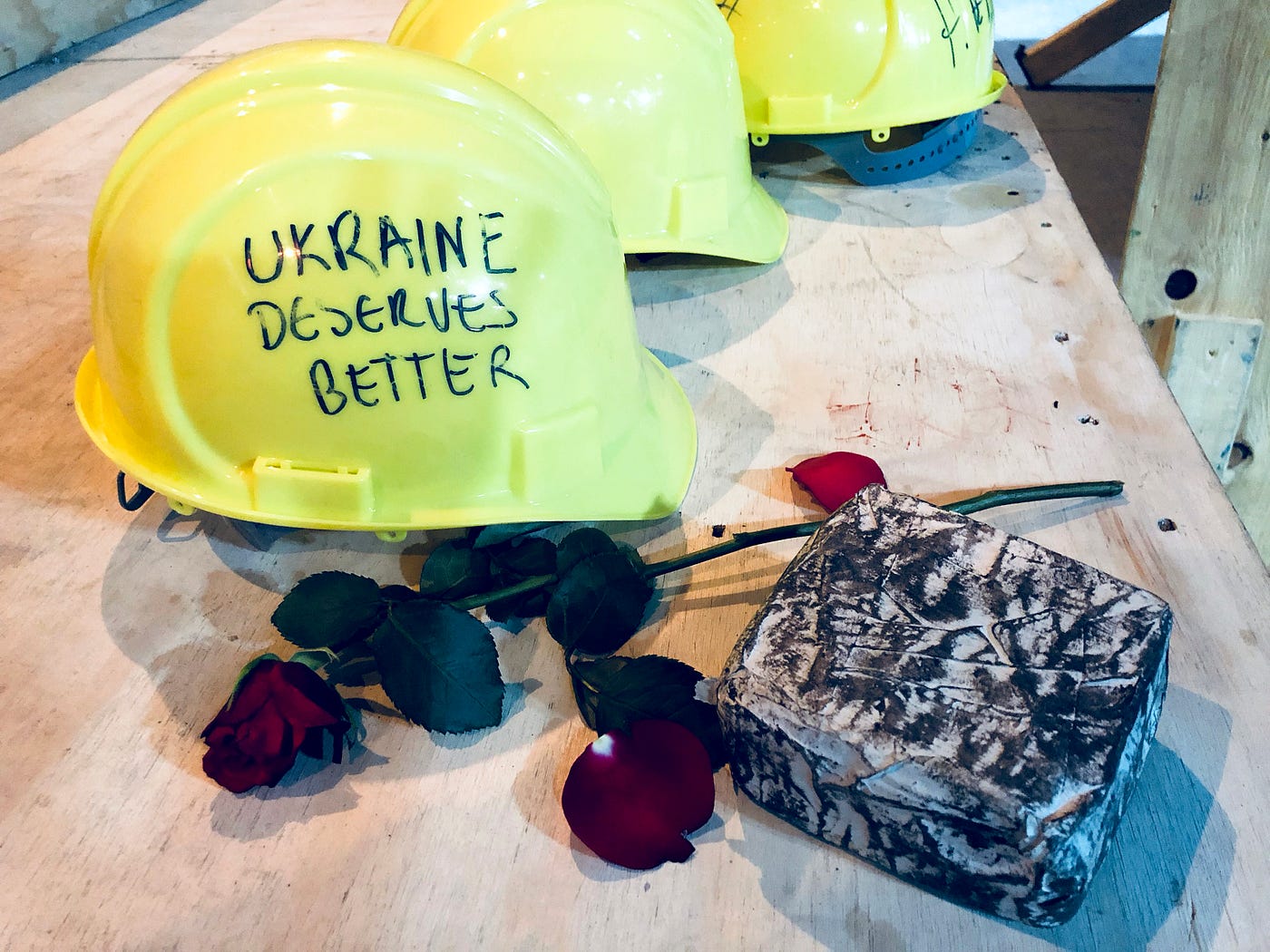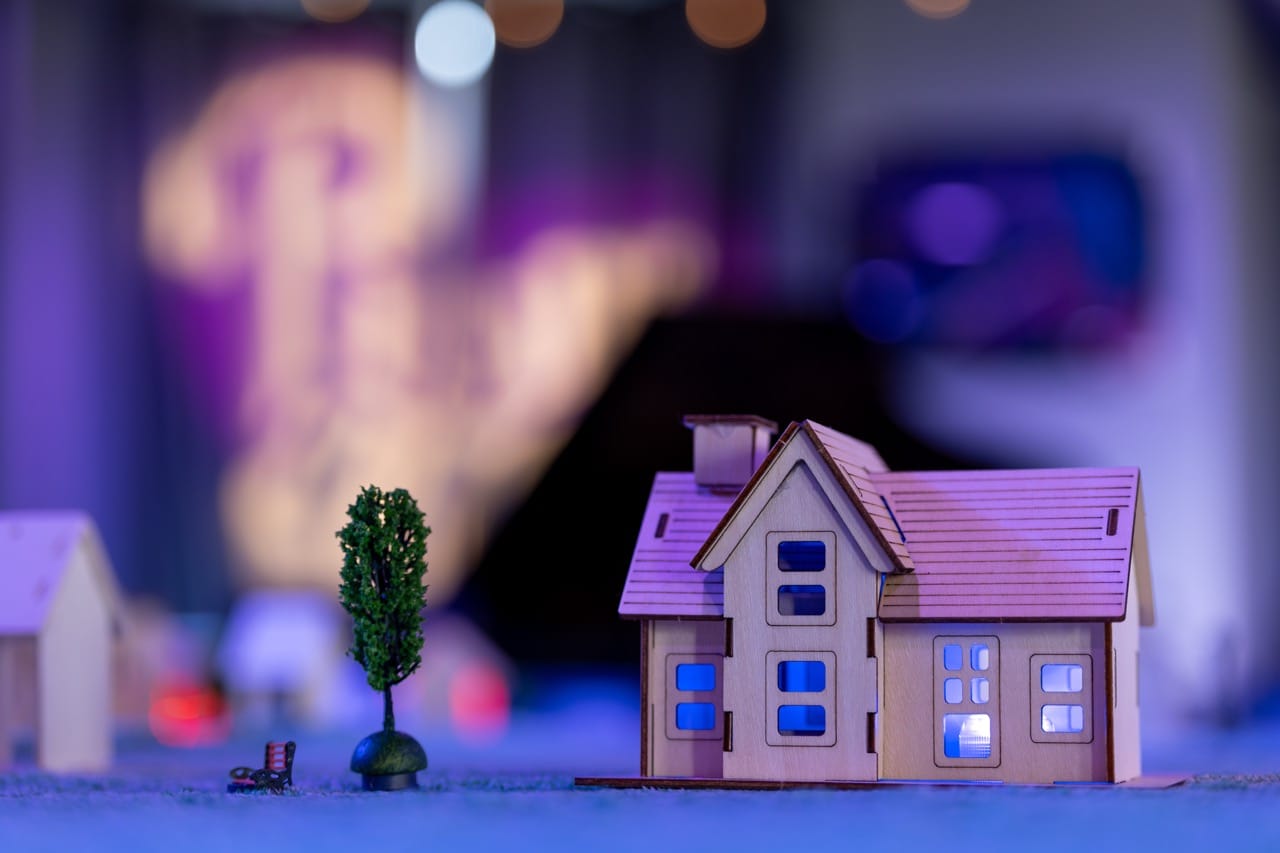A thrilling, musical retelling of a Ukrainian protest movement

I’m holding a protest sign written in Ukrainian. (At least I think it’s Ukrainian.) I look over my shoulder to see multiple people climbing up a rickety looking green tree-like sculpture, attaching signs and flags with clothespins and string. I’m surrounded by the members of a brass band, singing a joyous folk song at the top of their lungs. The song they sing is also in Ukrainian. Their clear-eyed faces reflect the atmosphere: committed, passionate, optimistic. Most of the audience find themselves on their feet, wrapped up in the rapidly intensifying festivities, which have quickly turned into an energetic gypsy-punk concert. The people around me are dancing and clapping their hands. I’m entranced.
A man extends his hand. I shake it. He’s wearing an innocent-looking sheep mask with tiny white ears that covers only the top half of his face. Underneath, black grease covers his eyes.
“Hi, what’s your name? I’m Michael.”
“I’m Kathryn.”
“Nice to meet you. Is this your first protest? Fun, isn’t it?”

But I’m not in Kiev, I’m in lower Manhattan, and this isn’t a real protest. This is Counting Sheep, is a personal recounting of the events of the Maidan Square protests in Kiev during 2014.
The show’s two co-creators, husband and wife team Mark Marczyk (a Canadian with Ukranian roots) and Marichka Marczyk (a Ukrainian), met on the streets of Kiev and fell in love during the tumult. The couple was inspired by their fellow protestors to explore the stories of their fellow Ukranian countrymen and countrywomen. Mark and Marichka also happen to lead the critically-acclaimed Lemon Bucket Orkestra from Canada, who describe themselves as a “guerilla-punk-Balkan-folk-brass” band. The result of all these events culminates in Counting Sheep: an energetic, immersive, fun folk opera sung entirely in Ukrainian, making its way to New York City via the Edinburgh Fringe Festival.
The show begins with dinner at a long wooden table and a quick prologue explaining the Maidan revolution. We watch real news clips and projected video of the events in 2014, shown on three of the four walls of the room, with occasional English captions. Tired of corruption and a President living on a 140-acre ranch (complete with a golden toilet), we learn that the people of Ukraine took to the streets after then-President Yanukovych refused to sign an agreement with the EU and opted for closer ties with Russia. After this high-level and brief explanation, the Maidan revolution begins in earnest and a flurry of activity erupts.
Audience members are thrown straight into the deep end, as the long dinner table in the center of the room turns into a makeshift stage and then gets assembled into a barricade between the protestors and the police. The story and the music flow in a rapid-fire fashion over the course of the next 70 minutes, with about three-fourths of the room choosing to participate in the activities, taking the side of the protestors. But there are no specific characters to follow in this production; the narrative is propelled forward by the progression of these real-life historical events re-enacted in 360 degrees, supplemented by video footage. The energy of the band/cast is infectious as we sing and dance our way through protests, a proposal and a wedding, and scuffles with the police, in this intense recreation of real events.

I am first seated on a wooden bench but quickly am taken by the hand and given a flag to wave. I dance down the dinner table, lead by a cast member, as the merry group parades past the seated attendees. The performers are tenacious in coaxing participation from the crowd throughout the show — everything from assembling first aid kits, throwing bricks (actually painted foam) at police in riot gear, cutting blue and yellow ribbons to pin on fellow protestors’ chests, or even learning the words to a protest song from a handout, lyrics in both English and Ukranian, thankfully. Even those up in the bleachers are encouraged to move around during the show, get up, eat, dance, and sing.
But discomfort is visible in the faces of more than a few attendees when asked to fling bricks at the police. I am not sure I will follow through when the time comes. But there’s no time to consider our own actions (or lack of action), especially without a traditional story or characters. I wished for the ability to delve into why one person might choose to march while another stays home. It’s simply too hard to discuss each person’s reasons for joining the movement or even their hopes for the country’s future when the only language spoken is in Ukrainian.
Get Kathryn Yu’s stories in your inbox
Join Medium for free to get updates from this writer.
SubscribeSubscribe
The big dramatic points of the show are presented as highly stylized clashes with the police. The first scene involving a mock bulldozer is breath-taking and shocking as we see a video of the real-life bulldozer plow into the assembled crowd, projected on the wall behind us. But more than a few of the later encounters rely upon live freeze frames and slow-motion action complete with rock show-style lighting; it feels a bit too much like a social media-ready music video: too tidy and perhaps a bit contrived.

The show does have some wonderfully touching, nuanced moments after the standoff with the authorities goes south. We the audience find ourselves crouching behind a hastily assembled barricade, staring at the line of police in riot gear on the other side. Meanwhile, band members interspersed in the crowd toss spool after spool of ribbon over our heads. The room quiets as we hear the tinny plunk of each spool land against a police shield and fall to the floor. I look up to see sad streams of red flowing down, tossed over piled-up tires and planks of wood. And when one musician runs out of spools to throw, I see him collapse against a nearby table in resignation, his head in his hands.
But despite Counting Sheep’s flaws, the experience itself expands to fill all the available emotional space. I found compelling musical performances and a deep connection with the performers, especially for audience members who choose to come into the center of the action and commit to the revolution.
At the height of the show, bandleader Mark Marczyk stops to weep. His ragtag team of musicians is performing a dirge after removing the body of a fallen protestor, shot by a hidden sniper. A fellow protestor, shot in the leg, limps away. As soon as the victim, wrapped in a blanket, is out of view, the music turns more frantic, more sorrowful. Mark’s eyes are red under his white ‘sheep’ mask as he plays an intricately decorated violin.
He pushes his body close to the audience member next to him, invading their personal space. Then the person next to him. Then the next person. Mark quickly makes his way around the room, still playing his violin. I can see several loose strings from his bow undulating in the air. The crowd is frozen.
He then turns to me and stops; he leans in close, and even closer still, his violin sounding even more desperate. His eyes are entirely focused on mine while the crowd around us fades from view. I do not dare look away. Without warning, he stops and keels over, onto the ground. His crouching body heaves from the sobs. The person to the left of me is crying, too.
In solidarity, I place two hands on Mark’s shoulders, in an attempt to comfort him.
He lingers, hanging over my shoe, breathing heavily. I hold my breath. He says nothing before getting up.
The show must go on. The music continues.
The show’s emotional core comes from its use of traditional Ukranian folk music. Counting Sheep’s haunting, polyphonic songs are instantly memorable in a revolutionary context; sung by a choir of a dozen performers scattered around the room, the music envelopes the audience. I can almost feel the sung notes permeating my skin. It’s impossible not to enjoy, as a horah breaks out during a wedding, or an entire section of the room gets conscripted into becoming the rhythm section. The folk songs are also well-chosen for the more contemplative moments as well. Plaintive melodies haunt the air as we kneel down on the floor during a drawn-out standoff with the police, and real-life news footage is projected onto the walls behind us.
Co-creator Marichka Marczyk’s background comes from ethnomusicology; she and her husband have traveled the country, documenting the folk songs of different areas. Many the songs in Counting Sheep come from small villages in the Eastern region of Ukraine: towns which no longer exist because they were wiped out during the war.

The music we hear in the production may be the only lasting record of these traditional songs, as one of the band members reveals to me after the performance is over. Without this piece, the songs of these people might have been otherwise lost. Thanks to the work of Mark and Marichka Marczyk and the rest of the Lemon Bucket Orkestra, this folk music can live on — perhaps to soundtrack the next revolution. Whenever that may be.
As Counting Sheep reminds us, the resistance continues.
Counting Sheep continues at 3LD in Manhattan through December 17. Tickets are $20–59.50. The album of the same name is also available on Bandcamp.
No Proscenium is a labor of love made possible by our generous backers like you: join them on Patreon today!
In addition to the No Proscenium web site, our podcast, and our newsletters, you can find NoPro on Twitter, Facebook, YouTube, Instagram, in our online community Everything Immersive, and in our Slack community.















Discussion